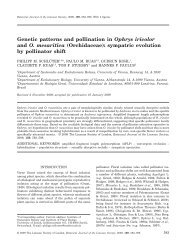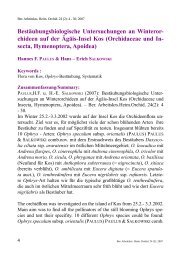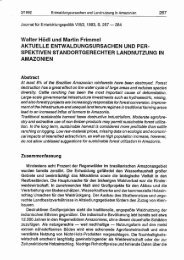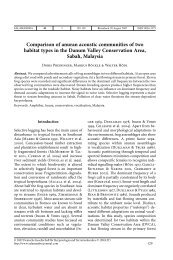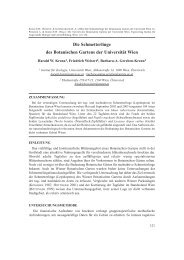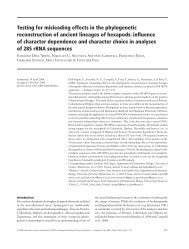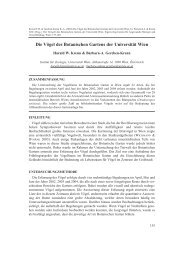Form, function and evolution of the mouthparts of - Department für ...
Form, function and evolution of the mouthparts of - Department für ...
Form, function and evolution of the mouthparts of - Department für ...
Create successful ePaper yourself
Turn your PDF publications into a flip-book with our unique Google optimized e-Paper software.
piercing apparatus. A hydrostatical mechanism is involved to<br />
compensate <strong>the</strong> volume <strong>of</strong> <strong>the</strong> stylets in <strong>the</strong> head capsule <strong>and</strong><br />
allows complete withdrawal <strong>and</strong> protraction (Tröster, 1990). Up to<br />
one third <strong>of</strong> <strong>the</strong> insect’s body mass can be ingested in a single<br />
sucking cycle, <strong>and</strong> <strong>the</strong> insect can imbibe several meals <strong>of</strong> blood each<br />
day (Lehane, 2005).<br />
3.1.3. Diptera (flies <strong>and</strong> midges)<br />
We listed eight groups <strong>of</strong> Diptera that are known to be at least<br />
occasionally parasitic on humans <strong>and</strong> that may transfer a great<br />
variety <strong>of</strong> pathogens (Table 1). Generally, <strong>the</strong>y visit <strong>the</strong>ir host<br />
organisms for brief periods <strong>of</strong> time to extract blood. All imagines <strong>of</strong><br />
Diptera have more or less elongated sucking <strong>mouthparts</strong> <strong>and</strong><br />
a suction pump in <strong>the</strong> head. The most prominent part <strong>of</strong> <strong>the</strong><br />
proboscis is formed by <strong>the</strong> labium which enshea<strong>the</strong>s <strong>the</strong> o<strong>the</strong>r<br />
components (i.e., labrum, m<strong>and</strong>ibles, laciniae <strong>and</strong> hypopharynx)<br />
<strong>and</strong> leads to <strong>the</strong> sponge-like labellum (homologs to <strong>the</strong> labial palps)<br />
at <strong>the</strong> apex. The food-canal is formed at least partly by <strong>the</strong> labrum<br />
while <strong>the</strong> elongated hypopharynx builds <strong>the</strong> salivary canal.<br />
3.1.3.1. Culicidae (mosquitoes). Mosquitoes are commonly not<br />
specialized to particular host organisms. The bulk <strong>of</strong> <strong>the</strong> worldwide<br />
3500 species is potentially <strong>of</strong> great importance for humans (Lehane,<br />
2005) since <strong>the</strong>y may transmit various pathogens (Table 1). The<br />
piercing-proboscis is several millimeters long <strong>and</strong> usually slightly<br />
shorter than <strong>the</strong> body. Generally, only <strong>the</strong> females are bloodfeeders.<br />
In addition to a blood diet, female Culicidae feed on plant<br />
fluids (e.g., floral nectar), which are <strong>the</strong> only sources <strong>of</strong> food for <strong>the</strong><br />
males. Accordingly, <strong>the</strong> piercing structures <strong>of</strong> <strong>the</strong> male proboscis<br />
are reduced (Wahid et al., 2003). The female proboscis in typical<br />
hematophagous mosquitoes, such as from <strong>the</strong> genera Aedes,<br />
Anopheles <strong>and</strong> Culex, consists <strong>of</strong> long, thin stylets formed by <strong>the</strong><br />
labrum, m<strong>and</strong>ibles, laciniae <strong>and</strong> hypopharynx, which lie in a groove<br />
<strong>of</strong> <strong>the</strong> labium (Fig. 4A <strong>and</strong> C). When <strong>the</strong> insect is at rest, all piercing<br />
structures are enveloped by <strong>the</strong> labium <strong>and</strong> <strong>the</strong> proboscis is folded<br />
under <strong>the</strong> body.<br />
The labrum forms a thin <strong>and</strong> almost entirely enclosed tube with<br />
an angular apex, <strong>and</strong> toge<strong>the</strong>r with <strong>the</strong> hypopharynx it forms <strong>the</strong><br />
food-canal <strong>of</strong> proboscis (Fig. 4B). The paired m<strong>and</strong>ibles are modified<br />
to thin acutely pointed structures. The paired laciniae <strong>of</strong> <strong>the</strong><br />
maxillae are long, extremely thin <strong>and</strong> finely serrate at <strong>the</strong> tip<br />
(Fig. 4D); <strong>the</strong>y build <strong>the</strong> main organ for piercing (Snodgrass, 1959).<br />
Inside <strong>the</strong> head capsule are protractor <strong>and</strong> retractor muscles which<br />
are attached to <strong>the</strong> base <strong>of</strong> <strong>the</strong> laciniae <strong>and</strong> cause its forward <strong>and</strong><br />
backward movements. Elastic structures store energy for a rapid<br />
protraction when <strong>the</strong> respective muscle is released (Wenk, 1980).<br />
H.W. Krenn, H. Aspöck / Arthropod Structure & Development 41 (2012) 101e118 107<br />
Fig. 3. A. Anterior body <strong>of</strong> a head louse Pediculus humanus capitis (Anoplura). Piercing structures are retracted into <strong>the</strong> head <strong>and</strong> not visible. B. Transparent preparation showing <strong>the</strong><br />
piercing structures inside <strong>the</strong> head. C. Cross-section <strong>of</strong> <strong>the</strong> frontal head; piercing structures (hypopharynx Hy, prementum Pm) in a cavity, formed partly by rudimentary maxillae<br />
<strong>and</strong> m<strong>and</strong>ibles.<br />
The multi-segmented <strong>and</strong> <strong>of</strong>ten elongate maxillary palp emerges<br />
from <strong>the</strong> base <strong>of</strong> <strong>the</strong> maxillae (Fig. 4A). The hypopharynx is likewise<br />
greatly elongated <strong>and</strong> forms a singular stylet which contains <strong>the</strong><br />
very thin salivary canal (Fig. 4B). The labella form <strong>the</strong> apex <strong>of</strong> <strong>the</strong><br />
labium <strong>and</strong> bear sensory organs (Fig. 4C), which presumably serve<br />
to locate a suitable area <strong>of</strong> <strong>the</strong> skin to penetrate.<br />
To begin feeding, <strong>the</strong> labella <strong>of</strong> <strong>the</strong> proboscis are brought into<br />
contact with <strong>the</strong> host. The labium remains on <strong>the</strong> outside <strong>the</strong> host’s<br />
body <strong>and</strong> bends backward when <strong>the</strong> stylets penetrate <strong>the</strong> skin. The<br />
laciniae cut deeper into <strong>the</strong> skin by sliding longitudinally against<br />
each o<strong>the</strong>r, while <strong>the</strong> fine teeth at <strong>the</strong> apex provide temporary<br />
anchorage. The o<strong>the</strong>r piercing organs are probably pulled along<br />
with <strong>the</strong> laciniae since appropriate muscles are not found in all<br />
investigated species (Smith, 1985). Blood is withdrawn from small<br />
blood vessels. The average amount <strong>of</strong> blood taken by Aedes aegypti<br />
is 4.2 ml; <strong>the</strong> rate <strong>of</strong> uptake is about 0.0016 ml/s (Kingsolver <strong>and</strong><br />
Daniel, 1995). As in o<strong>the</strong>r Diptera, a series <strong>of</strong> two suction pumps<br />
ensure a continuous stream <strong>of</strong> blood. The anterior pump is<br />
a formation <strong>of</strong> <strong>the</strong> preoral cavity, it has a solid floor <strong>and</strong> a flexible<br />
ro<strong>of</strong>, which is stretched <strong>and</strong> compressed by muscle activity. The<br />
posterior suction pump is located in <strong>the</strong> pharynx; that can be<br />
extended by muscles <strong>and</strong> is probably <strong>the</strong> more powerful <strong>of</strong> <strong>the</strong> two<br />
suction pumps (Kingsolver <strong>and</strong> Daniel, 1995).<br />
The withdrawal <strong>of</strong> stylets is probably achieved by <strong>the</strong> alternating<br />
forward <strong>and</strong> backward motion <strong>of</strong> <strong>the</strong> laciniae. At <strong>the</strong> same<br />
time, <strong>the</strong> mosquitoes pull <strong>the</strong> piercing organs out <strong>of</strong> <strong>the</strong> host’s skin<br />
by extending <strong>the</strong>ir legs <strong>and</strong> by contraction <strong>of</strong> head muscles.<br />
3.1.3.2. Simuliidae (black flies). Many species <strong>of</strong> <strong>the</strong>se hematophagous<br />
insects are host-specific, whereby only a small fraction <strong>of</strong> <strong>the</strong><br />
1500 species are relevant to humans (Lehane, 2005). The female<br />
Simuliidae are small but very unpleasant blood-feeders. Their<br />
<strong>mouthparts</strong> are relatively short <strong>and</strong> form a hardly recognizable<br />
piercing-proboscis (Fig. 5A). Their stab causes a pool <strong>of</strong> blood to<br />
form under <strong>the</strong> skin from which <strong>the</strong>y are able to suck using <strong>the</strong>ir<br />
short proboscis. The labrum, m<strong>and</strong>ibles, laciniae <strong>and</strong> hypopharynx<br />
compose <strong>the</strong> actual piercing organ, which lies in a groove formed<br />
by <strong>the</strong> labium which apically bears <strong>the</strong> labella (Fig. 5A) (Wenk,<br />
1962; Chaudonneret, 1990).<br />
The labrum is a triangular, elongated plate, which toge<strong>the</strong>r<br />
with <strong>the</strong> anteriorly positioned m<strong>and</strong>ibles form <strong>the</strong> food-canal<br />
(Fig. 5B). To begin feeding, <strong>the</strong> labrum <strong>and</strong> hypopharynx are<br />
extended <strong>and</strong> press against <strong>the</strong> host’s skin so that <strong>the</strong> terminally<br />
positioned teeth bend forward or backward. The serrate m<strong>and</strong>ibles<br />
lie adjacent to each o<strong>the</strong>r <strong>and</strong> overlap. The contraction <strong>of</strong> <strong>the</strong><br />
adductor muscles results in a scissors-like movement <strong>of</strong> <strong>the</strong>



